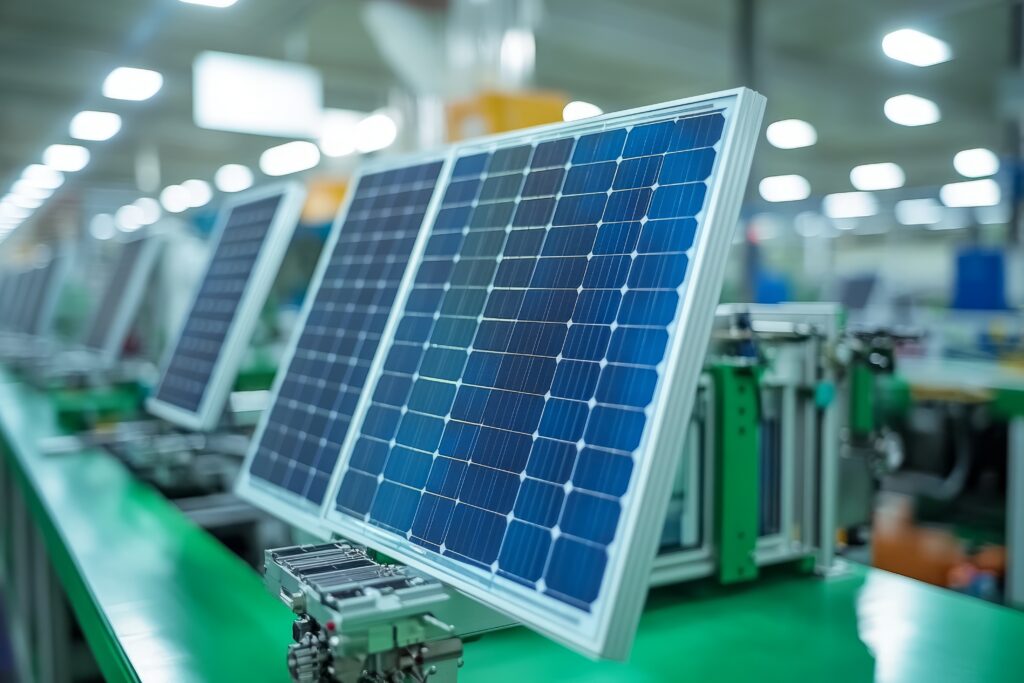



Solar Panel Technology, a cornerstone of renewable energy, operate on a fascinating principle: they convert sunlight into electricity using a process called the photovoltaic effect. This mechanism involves several critical components and steps, turning sunlight into usable electric power for homes, businesses, and the grid.
The Basics of Solar Panel Technology
At the heart of every solar panel are photovoltaic (PV) cells. These cells are typically made of silicon, a semiconductor material that holds special properties allowing it to absorb light. When sunlight, comprised of energy-rich photons, strikes the surface of the solar cell, it excites the electrons in the silicon atoms, knocking them loose and allowing them to flow freely.
The Photovoltaic Effect
The photovoltaic effect is the principle that underpins how solar panels generate electricity. Here’s how it works in detail:
- Absorption of Sunlight: When photons hit the silicon cells, they’re absorbed, transferring their energy to silicon atoms.
- Electron Excitation: The energy from the photons excites the electrons, giving them enough energy to escape from their normal position in the silicon atom.
- Electric Field Creation: The structure of a solar cell consists of two layers of silicon, one doped with phosphorus (N-type silicon) and the other with boron (P-type silicon). The junction between these two layers creates an electric field, which directs the flow of free electrons.
- Electric Current Generation: As the electrons flow toward the N-type layer, they create a current. This flow of electrons constitutes electricity.
System Components
A Solar Panel Technology system includes several basic components beyond the solar panels themselves, including:
- Inverters: These devices convert the direct current (DC) electricity generated by solar panels into alternating current (AC) electricity, which is the standard form for household electricity use.
- Mounting Systems: Solar panels are typically mounted on rooftops or ground-mounted systems, allowing them to be positioned optimally toward the sun.
- Battery Storage: In some systems, batteries are included to store excess electricity generated for future use, allowing solar power to be utilized even when the sun isn’t shining.
- Charge Controllers: These devices regulate the electricity flow between the solar panels and batteries, preventing overcharging and extending the battery’s life.
Efficiency and Performance
The efficiency of solar panels varies based on the type and quality. Traditional silicon-based panels typically have efficiencies in the range of 15% to 22%, meaning that 15-22% of the sunlight hitting the panels is converted to electricity. Higher efficiencies can be found in advanced technologies like bifacial panels, which capture sunlight from both sides, and multi-junction cells, which can achieve efficiencies above 40% under concentrated sunlight.
Environmental factors significantly impact solar panel performance. These include:
- Sunlight Availability: Regions with high solar irradiance perform better; however, panels can generate electricity on cloudy days too.
- Temperature: While sunlight enhances electricity production, high temperatures can decrease efficiency. Panels generally operate more efficiently at cooler temperatures.
- Angle and Orientation: Ensuring that panels are optimally tilted and oriented can maximize exposure to sunlight throughout the day.
Solar Panel Technology Advancements
Research and development in Solar Panel Technology continue to drive innovation. Here are some recent advancements:
- Bifacial Solar Panels: These panels can capture sunlight from both sides, increasing energy generation and efficiency, particularly in areas with high albedo (reflectivity).
- Thin-Film Solar Cells: Made from materials that are thinner than traditional silicon cells, these can be lightweight and flexible, opening new applications in building-integrated photovoltaics (BIPV) and portable electronics.
- Transparent Solar Cells: Emerging technologies are developing transparent photovoltaic cells that can be integrated into windows, potentially converting buildings into energy-generating structures without sacrificing aesthetics.
- Perovskite Solar Cells: A promising new type of solar cell that uses a specific crystal structure called perovskite, they have shown rapid efficiency improvements and can be manufactured cheaply.
The Future of Solar Panel Technology
As Solar Panel Technology continues to evolve, its role in the global energy landscape becomes increasingly vital. Government policies supporting renewable energy, alongside decreasing costs of solar technologies, are paving the way for widespread adoption. With sustainability becoming a top priority, harnessing the sun’s energy not only mitigates the impacts of climate change but also supports energy independence for many nations.
The transition to solar energy reflects a significant shift in how we produce and consume energy, highlighting the efficiency and sustainability of harnessing a source that is both abundant and renewable. As innovations continue and costs decrease, solar panels may soon become a common sight, transforming our energy infrastructure into a cleaner and more sustainable system for generations to come.
Stay informed and engaged withSolar Panel Technology developments at Andromeda Energy.
For Further Detail
https://www.renewableenergyworld.com/


Leave a Reply